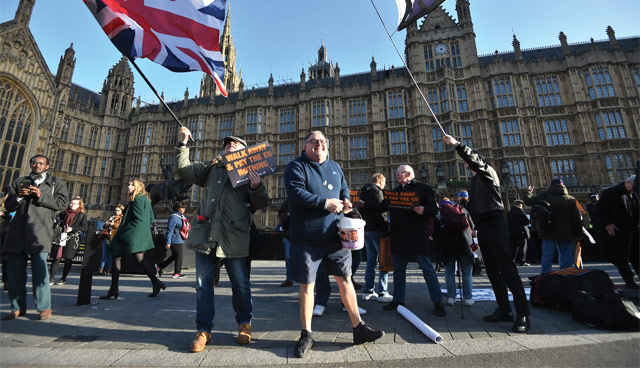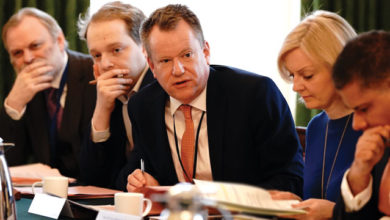Brexit chaos

With the UK leaving the European Union on 29 March 2019, the chaos that is Brexit continues. Owen McQuade looks at some of the fundamentals amongst the confusion and how Brexit comes down to essentially two choices: Brexit in name only, ‘Brino’, or the economic catastrophe of the UK crashing out with no withdrawal agreement.
The chaos of Brexit was accurately reflected in Theresa May’s decision to defer the Parliamentary vote on the withdrawal agreement. May admitted expectations of a “significant” loss, something that had been on the cards longer than the three days of bruising debate in the House of Commons. This brought about a string of bloody noses for the Government but the size of the potential defeat on the most important issue put before parliament in more than 40 years goes someway to emphasise what the FT’s Robert Shrimsley describes as “a zombie premiership”.
The current withdrawal agreement, styled as ‘Theresa May’s deal’ by the media, is really the pathway to a soft Brexit or as Professor Ronan McCrea from University College London calls it a ‘pointless Brexit’. An extension of Article 50 was thought only possible if there is a general election or a constitutional crisis in the UK. However, with the SNP’s legal challenge, it will be possible for the UK to receive an extension without the agreement of all the EU27. This opens the real prospect of the UK remaining in the European Union.
On the other extreme, the macroeconomic impact of the ‘no deal’ option is stark, with interest rates forecast to rise to 5-6 per cent and sterling to collapse, with a significant impact on Irish exporters to the UK. There is essentially a binary choice of crashing out or having a ‘pointless Brexit’ – effectively remaining in the customs union and single market but having no democratic input within the institutions.
Stepping back from the daily twists and turns of Brexit, Fintan O’Toole identifies an inescapable truth; the UK has chosen to become a ‘second tier’ European nation state. Despite scathing references to ‘project fear’, the UK will undoubtedly be poorer as a result of Brexit. In May 2018, the Bank of England estimated that the average UK household was £900 worst off since the vote to leave. Brexit will leave the British poorer, the only uncertainty is to what extent this will be the case.
Another issue that has become clear since the referendum vote has been Britain’s attitude to Ireland’s plight. Of the EU27, Ireland will be the most impacted by Brexit, however, the attitude in the British media and body politic has been at best indifferent and often hostile to this reality. The chaos evident in the two-year period for the withdrawal agreement does not bode well for negotiation for the longer-term trade relationship between the UK and the EU.
Post-withdrawal
Negotiations for a future trade deal can only start once the UK has left the EU. The content of the negotiations will be informed by the ‘political declaration’ on future UK-EU relations which has been drafted along with the withdrawal agreement. Before negotiations begin, the member states will need to agree a mandate for the Commission which will pursue the negotiations. Such a mandate may not be forthcoming until well into the second half of 2019 as a result of the elections to the European Parliament and the formation of a new Commission which will take office in November 2019.
Trade negotiations commonly require several years and take longer depending on how bespoke the relationship is and the more it deviates from an existing model. This does not bode well for the UK’s negotiations given the British Government’s aspirations, which are often contradictory. There is, therefore, the prospect of the negotiations extending well into, and potentially beyond, the transition period which is expected to end on 31 December 2020. This is why Michel Barnier has already raised the possibility of an extension.
If no agreement is in place after the transition period, the UK faces a second ‘no deal’ scenario. This would entail the UK ‘falling out’ of the customs union and single market and other arrangements with the EU; the exception will be Northern Ireland given the proposed backstop.
Even if negotiations are concluded, the agreement will have to be ratified. The expectation is that the agreement will have to be agreed unanimously by each of the EU27. This means securing parliamentary approval of the agreement and a referendum in one, or more, member states cannot be ruled out. The European Parliament will also need to give its approval. All this could take 18 months, if not longer, although it may be possible to introduce the trade and some other elements via an interim agreement. Therefore, it is likely to be several years after 29 March 2019 that the UK has its new relationship with the EU in place.
The approach taken by both parties in this second phase will be critical. The attitude adopted with the Canadian deal of ‘nothing is agreed until everything is agreed’ will lead to a long drawn out process that could take many years. The Canadian trade deal took seven years and is still not fully completed. It runs to over 1,600 pages which is a long way from the 27 pages of the political statement agreed at present.
In the first phase, there have been many practicalities, particularly around the Irish border and these will flow into the next and indeed, the complexity and scale of the challenges seems to constantly rise. For instance, animal inspections under EU rules must be carried out by fully-qualified vets and there is presently an insufficient number of vets in Ireland to undertake such checks. Amidst such complexity; British politics looks polarised for the foreseeable future and the chaos looks set to continue.





